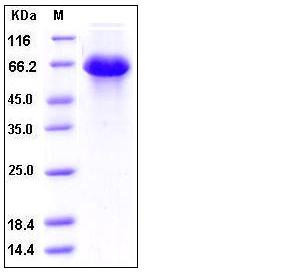Human SerpinD1 Protein (His Tag)
D22S673,HC2,HCF2,HCII,HLS2,LS2,SerpinD1,THPH10
- 100ug (NPP4259) Please inquiry
| Catalog Number | P10295-H08H |
|---|---|
| Organism Species | Human |
| Host | Human Cells |
| Synonyms | D22S673,HC2,HCF2,HCII,HLS2,LS2,SerpinD1,THPH10 |
| Molecular Weight | The mature recombinant human SerpinD1 consists of 491 amino acids and predicts a molecular mass of 56.4 kDa. By SDS-PAGE under reducing conditions, the apparent molecular mass of rhSerpinD1 is approximately 65-70 kDa as a result of glycosylation. |
| predicted N | Gly 20 |
| SDS-PAGE |  |
| Purity | > 97 % as determined by SDS-PAGE |
| Protein Construction | A DNA sequence encoding the human SerpinD1 precursor (NP_000176.2) (Met 1-Ser 499) was expressed with a C-terminal polyhistidine tag. |
| Bio-activity | Measured by its binding ability in a functional ELISA. Immobilized recombinant human SerpinD1-His (P10295-H08H) at 10 μg/ml (100 μl/well) can bind biotinylated recombinant mouse ELANE-His (P50204-M08H) with a linear range of 0.15-10.0 μg/ml. |
| Research Area | Developmental Biology |Metabolism |Vitamins / Minerals |
| Formulation | Lyophilized from sterile PBS, pH 7.4 1. Normally 5 % - 8 % trehalose and mannitol are added as protectants before lyophilization. Specific concentrations are included in the hardcopy of COA. |
| Background | SerpinD1, also known as heparin cofactor II (HCâ…¡), is a member of Serpin superfamily of the serine proteinase inhibitors. HCII is a glycoprotein in human plasma that inhibits thrombin and chymotrypsin, and the rate of inhibition of thrombin is rapidly increased by Dermatan sulfate (DS), heparin (H) and glycosaminoglycans(GAG). The stimulatory effect of glycosaminoglycans on the inhibition is mediated, in part, by the N-terminal acidic domain of HCII. Interestingly, a C-terminal His-tagged recombinant HCII exhibits enhanced activity of thrombin inhibition. It has been suggested that HCII plays an unique and important role in vascular homeostasis, and accordingly mutations in this gene or congenital HCII deficiency is potentially associated with thrombosis. HCII specifically inhibits thrombin action at the site of vascular wall injury and HCII-thrombin complexes have been detected in human plasma. HCII protects against thrombin-induced vascular remodeling in both humans and mice and suggest that HCII is a predictive biomarker and therapeutic target for atherosclerosis. SerpinD1 also inhibits chymotrypsin, but in a glycosaminoglycan-independent manner. |
| Reference |
